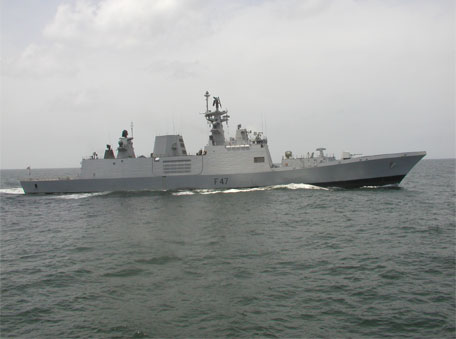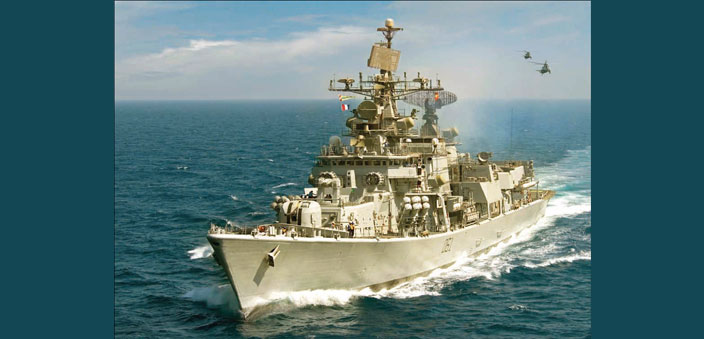No other slogan in recent history has evoked so much interest globally, as ‘Make in India’. If implemented well, it can certainly make India emerge as the world’s leading economic power. The defence sector is of particular interest for ‘Make in India’ because investment in this sector is many times more rewarding than corresponding investment in the commercial sector, in terms of employment generation and absorption of newer technologies.
Indian Navy made indigenisation a fundamental tenet of its planning and growth soon after Independence, because it realised that indigenisation will not only support and encourage the resurgence of India’s own industry but it will also cut costs and dependence on foreign nations, since import of military systems necessitates continued import of spares, upgrades and accessories throughout their life cycle. Indigenisation has been Navy’s motto, which it is justifiably proud of. Indian Navy has supported not only PSU (Public Sector Unit) shipyards, but more recently even the private shipyards, so that they too can participate in nation building. It has also been supporting indigenous development and manufacture of ever bigger and more complex equipment that go into our warships.
India’s naval strength
Today, India is one of the few nations that have the capability to design and build warships. In fact, with the commencement of the Indigenous Aircraft Carrier project, India becomes the fourth nation in the world with the capability of designing and building 40000T plus aircraft carriers. Indian Navy is also the only Navy with in-house design capability; the user and the designer are also organisationally integrated, a big plus that ensures that Indian warships are reasonably modern at the time of delivery, have ever increasing indigenous content, and find high user acceptability.
The background
Creation of any engineering equipment or system begins with its design. India, unfortunately, missed the Industrial Revolution. Therefore, at Independence, while it did have limited manufacturing facilities, there was no engineering design capability worth its name. This meant either direct import, or manufacturing of goods under license. While foreign companies were willing to provide technical know-how for manufacture of non-military goods for commercial gains, supply of military technology was dictated by geo-political interests. Obviously, no nation would ever share latest technology with others. Besides, military technology rapidly becomes obsolete and needs continuous support of R&D. Therefore, at Independence, the country had no warship construction capability.
Realising that no maritime nation can remain relevant in global maritime scenario without the ability to design, build and support its naval platforms, the top leadership of the post-Independence Navy decided to strongly support indigenous warship design and construction, a foresight that transformed it from Buyers’ Navy to Builders’ Navy.
The early designs
In the mid-sixties, a modest beginning was made, setting up a small Central Design Office (CDO), for design of small crafts and auxiliaries. In 1970, the Directorate of Naval Designs (DND) was set up as a part of Naval Headquarters (HQs) by re-appropriating its resources. This arrangement of DND being a part of the NHQ was a blessing in disguise as it enabled absorption of mid-stream changes that are inevitable in warship construction with long gestation periods, given the rapid obsolescence of military technology.
Design of a modified Seaward Defence Boat with significantly higher performance parameters including increase of speed from 15 knots to 30 knots was the first project implemented by Indian designers, without any past experience. S. Parmanandhan, the then Director (later to become the first Director General) of Naval Designs, who can truly be called the father of indigenous warship design, then took on the design of a new frigate using Leander design as the basis, but with payload as desired by the naval staff. The result was the Godavari Class design that took many with surprise at home and abroad, because, despite its much larger size and use of same propulsion machinery, the new ship was able to achieve higher speeds than the smaller Leander.
Since then, the story of the Directorate General of Naval Designs (DGND), has been that of one successful design after the other, including LCUs, Survey ships, LSTs, P-25 & P-25A “Corvettes”, P-15 “Destroyers” and P-16A, the follow-on of Godavari Class, which though initially intended to be of repeat design, finally acquired a new look; again, an acknowledgement of the rapid obsolescence of military technology and relatively slow warship construction, also underpinning the fact that without in-house design capability, indigenous warship construction is unsustainable.
Indian Navy’s current capabilities
Towards the end of the 20th century, ship signatures assumed considerable importance in naval warfare. Indian Navy too decided that all its future frontline platforms will be stealthy, ie., not susceptible to easy detection. To deal with this challenge and to handle resultant increased complexity in warship design and construction processes, the Navy’s design organisation reorganised itself and built up considerable vertical specialisation in core areas of design, such as Signature Management, Hydrodynamics, Structural design, Propulsion System Integration and HVAC. This significantly enhanced its capabilities to design state-of-the-art warships. The first fruit of this capability was the design of P-17 class multi-role stealth frigates, with enhanced operational capabilities in terms of survivability, stealth, sea keeping, ship handling and weapons. Three ships of this class, namely, Shivalik, Satpura and Sahyadri have already been delivered by MDL (Mazagon Dock Ship Builders Limited).
During this period, the MDL was also tasked to build three destroyers as follow on of Delhi class, designated as P-15A. Since, the naval designers had already built up expertise in stealth technology, they were able to incorporate many of these features in this design as well.

Today, DGND, MDL and GRSE (Garden Reach Shipbuilders & Engineers Ltd) are already working on two new futuristic designs, i.e., stealth destroyer P-15B, 4 of which are already under construction at MDL, and a stealth frigate P-17A, seven of which are to be built jointly by MDL and GRSE. Needless to say that these ships will be comparable to the best in the world, just like their predecessors and built at half the price thanks to the cost competitiveness of our shipyards. In all, our defence shipyards have delivered close to 100 ships of different classes.
At the start of the 21st century, conscious of its increased responsibilities in the changing global maritime scenario and resultant need for significantly larger number of frontline warships, our Navy felt the need to expand the core warship design capability as well the warship building capacity in the country.
Therefore, it was decided to utilise the limited resources of DGND for core functional design activities only, and transfer the less complex detailed design and production drawings to the shipyards. Accordingly, while DGND concurrently worked on the functional designs of Projects 17, 15A and the Indigenous Aircraft Carrier (IAC), the most prestigious project taken-up so far by the Indian designers, the detailed design of these projects were transferred to the respective shipyards.
Modernisation of shipbuilding infrastructure
As the building facilities at our PSU yards were quite archaic, modernisation of building infrastructure has been undertaken in all the four PSU shipyards during the past decade with new building berths and wet basins, block outfitting shops, high capacity cranes, mechanised transporters and allied facilities to enable them to adopt modern shipbuilding processes like integrated construction and enhance their throughput. The Navy went a step further and funded part cost of this modernisation. Today, infrastructure at all the PSU shipyards is significantly augmented and modernised, which should not only help in speeding up the construction process, increasing their throughput, but should also result in significant labour saving and higher product quality.
Looking into the future
Indian Navy is at the threshold of a major transformation and rapid growth. A fleet strength of roughly 140-150 ships is envisaged by 2022. Additionally, 80-90 ships are also envisaged for the coast guard. This translates into a need to build anywhere between 12 to 15 ships annually for the next at least 15 years, and is clearly an opportunity for many new players in the private sector. Realising this, based on an approach paper submitted by the Indian Navy in 2008-09, MoD (Ministry of Defence) has already made provisions in the DPP (Defence Procurement Procedure) to involve private Indian shipyards in the warship building activity to enhance gross national throughput.
Unlike the merchant ship industry, warship demand is not cyclic in nature, making it more attractive than commercial shipbuilding. Also, unlike commercial ships, there is no competition for warships from foreign shipbuilders. Therefore, Indian private shipyards must grab this opportunity. This will benefit not only the Navy and the shipyards, but the nation as a whole in creating additional jobs. Once this capacity is built up, it can be used to meet export potential for warships to third-world countries. This market is presently in the hands of European shipbuilders, with whom Indian yards can easily compete. However, this is where collaborative work and hand holding will play a vital role. Both DGND and the PSU shipyards must take private design houses and shipyards under their wings, grooming them to become as capable as themselves, otherwise this opportunity may get lost.


 [/column]
[/column]